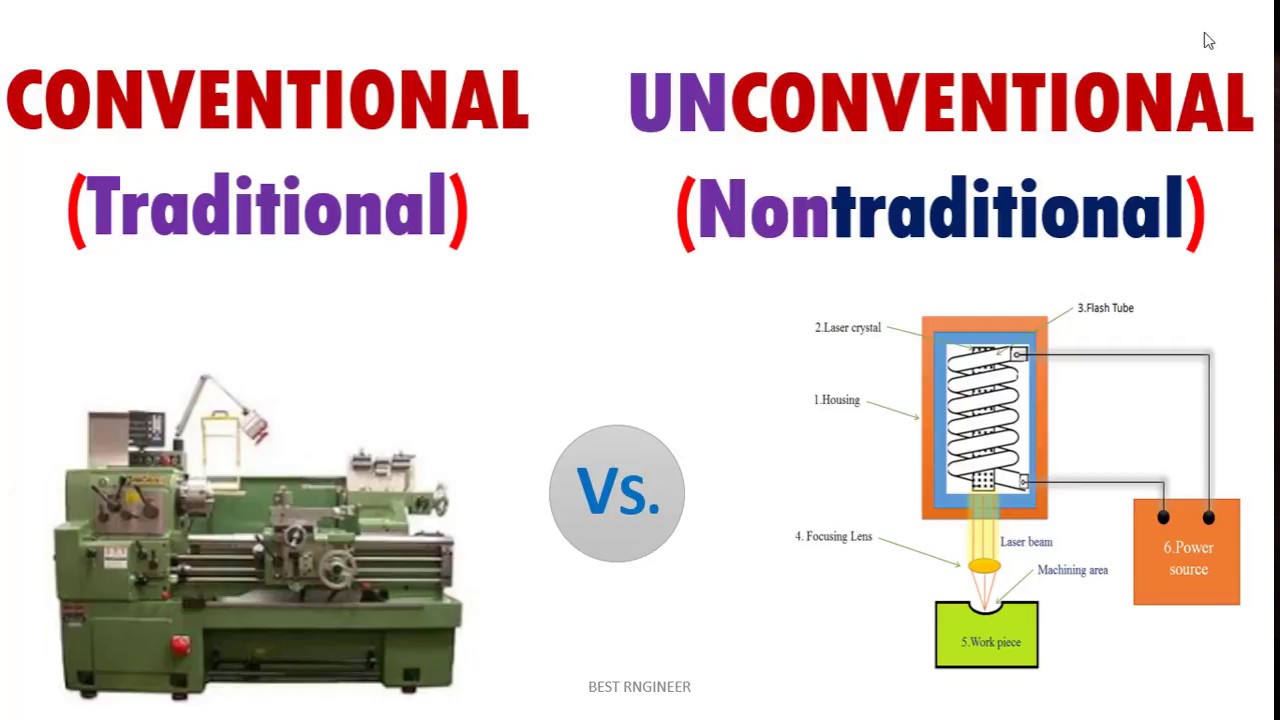The difference between the conventional (traditional) and the non-conventional (non-traditional) process is obvious due to the method used in performing their operations. The majority of individuals are unaware that the manufacturing process is divided into two categories: primary and secondary operations. The primary process produces the material’s fundamental form and size, while the secondary process, also known as machining, produces the final shape and size with tighter control over dimensions, surface qualities, and other factors. To fully comprehend the secondary manufacturing process, you must first understand the distinction between conventional and non-conventional machining.

In this article, you’ll get to know the difference between traditional and non-traditional machining processes. You’ll also get to know their advantages and disadvantages in their various applications.
Read more: Steps involve in the machining process
Contents
Conventional and non-conventional machining process
Non-conventional machines, on the other hand, are those that work automatically with the assistance of computers, without the need for human intervention or an operator. These are usually controlled by a computer or an autonomous robot. Automobile painting at automotive manufacturing plants, welding car units, and manufacturing processes involving severe high and low temperatures that people cannot withstand are examples of operations that require non-conventional machines.
The traditional method of machining necessitates direct contact between the tool and the work material. To cut an aluminum bar, for example, a fast-revolving iron cutter is required. This approach necessitates physical contact between the cutting instrument and the substance to be sliced. There is no contact between the machine tools and the material in this procedure. Infrared beam, laser beam, electric arc, plasma cutting, and electric beam are examples of non-traditional tools utilized.
Read more: Understanding Machining process and machine tool
Difference between traditional and non-traditional machining process
Instruments Employed
A physical tool must always be present in a traditional machining operation. A cutting tool in a Lathe machine, for example. A physical tool, on the other hand, may not be present in a non-conventional machining process. In laser machines, for example, laser beams operate, whereas electrochemical machining necessitates the use of a physical tool.
Accuracy
The accuracy and surface quality of conventional machining is lower, but non-conventional machining is more accurate and has a better surface finish.
Contact between the tool and the workpiece
The conventional machining method requires direct contact between the tool and the workpiece, whereas unconventional machining does not.
Waste Materials
Because traditional machining processes use tools that have a shorter lifespan due to increased surface contact and wear, they are more likely to waste material. Non-traditional machining produces less waste material due to little or no wear with longer-lasting tools.
Read more: Conventional and non-conventional types of machining processes
Process of Machining
A traditional machining method usually entails modifying the contour of a workpiece with a tougher material implement. Using traditional processes to machine hard metals and alloys requires more time and energy, resulting in higher costs. Conventional machining may not be possible in some instances.
Source of Energy
The term “conventional machining” refers to a method that employs mechanical energy. Other types of energy are used in non-traditional machining. Thermal, chemical, and electrical energy are the three basic types of energy employed in non-conventional machining.
Examples
Turning, boring, milling, shaping, broaching, slotting, grinding, and other traditional machining processes are examples. Non-conventional machining technologies include Abrasive Jet Machining (AJM), Ultrasonic Machining (USM), Water Jet and Abrasive Water Jet Machining (WJM and AWJM), and Electro-discharge Machining (EDM).
Read more: Understanding conventional machining process
Watch the video below to learn more about the difference between traditional and non-traditional machining processes:
The table below shows the difference between conventional and non-conventional machining processes:
| Sr. No. | conventional or traditional machining | Non-conventional or Nontraditional machining |
| 1 | An unsatisfactory surface finish is achieved. | A better surface finish is achieved. |
| 2 | It is not suitable for small-scale machining. | It can be used for small-size machining. |
| 3 | Tool wear is a concern, and as a result, tool life is reduced. | Because there is a problem with tool wear, the tool’s life is extended. |
| 4 | Less investment or capital cost. | More capital or investment cost. |
| 5 | Direct contact between tool and workpiece. | No direct contact between the tool and workpiece. |
| 6 | It can’t make micro holes. | It can make micro holes. |
Read more: Understanding honing process
That is all for this article where the difference between conventional and non-conventional machining is being discussed. I hope you get a lot from the reading if so, kindly share with other students. Thanks for reading, see you around!

Leave a Reply